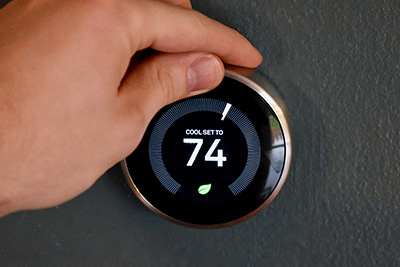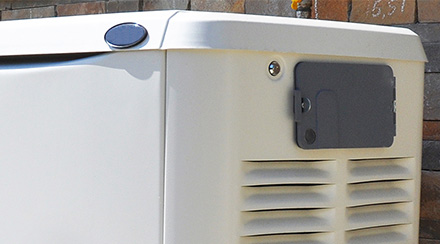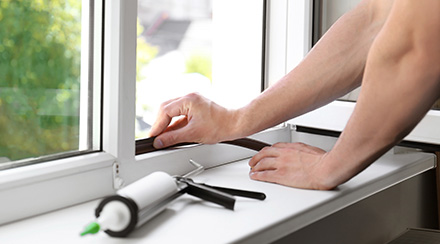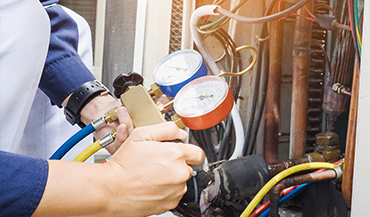What's the Best Summer Thermostat Setting?
Some folks dread the summertime heat, while others look forward to the warm weather all year long. But one thing we can all agree on is that we want to keep our summertime home cooling bills as low as possible. And while there are lots of ways we can help keep cool air inside and hot air outside, one of the most fundamental things we can do to control cooling costs is to set the thermostat as high as comfortably possible.

Recommended Thermostat Settings for Summer
Many people have strong opinions about what temperature to set the thermostat in summer, and the reality is that there’s no magic number. ENERGY STAR, the federal program that helps consumers find energy-efficient appliances and electronics, learned this the hard way in 2019 when it added new thermostat recommendations to its website. It used an example of a home kept at 78 degrees Fahrenheit when occupants are home, 82 degrees when they’re asleep and 85 degrees when the home is empty. As you might imagine, the social media reaction revealed that many folks found these temperatures uncomfortably high.
ENERGY STAR responded to the Internet buzz with a clarifying statement: “In order to save energy, the ENERGY STAR website recommends owners of programmable thermostats increase the air conditioning temperature setting by 7 degrees F when homes are unoccupied and by 4 degrees F when occupants are asleep.”
In other words, comfort is personal, and the best AC temperature for summer will differ from one person to the next, but the key to saving energy with your thermostat is in setting the temperature a little higher when it won’t affect your comfort level.
Find Your Best AC Temperature for Sleeping, Daytime and When You're Away
When experimenting with your best AC temperature for sleeping at night and activities during the day, the convenience of doing so depends on what kind of thermostat you have. There are three basic types of thermostats: manual, programmable and smart thermostats.
With a manual thermostat, you need to be physically touching your thermostat to change the temperature. This means that, to save energy on cooling, you’ll need to manually raise the temperature whenever you go to bed or leave the house, and the temperature may be higher than you’d prefer when you wake up or return home.
A programmable thermostat can automatically raise or lower the temperature on a customized schedule. Setting the schedule is usually done manually with controls on the thermostat. As long as you stick to your usual routine, you’ll wake up in (or come home to) a comfortably cool house – but if you change your routine, your thermostat won’t automatically adjust.
A smart thermostat is like a programmable thermostat that is connected to the Internet and can be controlled from anywhere using a smartphone or tablet. With a smart thermostat, your temperature settings can be as flexible and spontaneous as you are – you’re always just a few taps away from saving energy and money.
If this is the first time you’ve tried to save money by adjusting your thermostat, start with ENERGY STAR’s recommendations: Try increasing the temperature by seven degrees when your home is empty and by four degrees when you’re asleep. If you find those changes easy to make, you could try increasing the temperature a little more, one degree at a time, until you find your ideal compromise between comfort and energy use.
And if those changes feel like too much, you can try smaller temperature increases – every little bit helps. If your best AC temperature for sleeping is closer to your waking temperature, even an increase of one or two degrees can make a difference.

How to Stay Comfortable When It’s Warmer
Increasing the temperature when you’re asleep or away is only one part of saving money on home cooling – another key to savings is staying comfortable while increasing your preferred baseline temperature.
There are lots of ways to cool off without turning down the thermostat. Here are some of our most useful tips:
- Use ceiling fans in occupied rooms. Make sure the blades are turning counterclockwise, which creates a cooling downdraft. But don’t use them in unoccupied rooms, because fans only cool people, not the air.
- Keep blinds and drapes closed during the day to block out excess heat from sunlight.
- Dress in lightweight, loose-fitting clothing.
- Avoid using heat-generating appliances during the hottest hours of the day. Save the use of your dryer, oven and stove for after dark.
- Upgrade any incandescent light bulbs in your home to LED bulbs. These bulbs last for years and consume a fraction of the energy used by incandescents, but most importantly, they don’t give off unwanted heat.
If you’re looking for even more ways to feel cooler at home while using less energy, you might want to invest in some home improvements. Our guide to weatherizing your home for summer offers advice for making your home more energy-efficient, especially when it comes to your cooling equipment. For ways to save money, we've put together tips to help you lower your electricity bill in the summer.
Give some of these ideas a try and experiment with higher thermostat settings, increasing the temperature one degree at a time. You may find that you can comfortably raise your baseline temperature more than you expected – and in combination with even higher settings overnight or when your home is empty, you can expect these changes to be reflected in lower monthly energy bills.
Looking for Something Specific?
Select a category to find resources for topics that interest you.
Select Category

Related Articles:

What to Do Before, During and After Power Outages
With a little knowledge and preparation, you can protect yourself, your home and your belongings during power outages of any duration.
Read Article
How to Choose a Generator for Your Home
Power outages can be miserable, but with the right generator, you can keep your family safe and comfortable until power is restored. Learn how to choose the best generator for your home.
Read Article
Weatherize Your Home for Summer
The extreme heat of summer can really do a number on your energy bills. But if you’re able to invest a little time and money into weatherizing to keep your home cool, you can help yourself and your family remain comfortable at home while still saving energy.
Read ArticleMost Popular Articles

Keep Your AC Running Efficiently
Airtron's air conditioning services can help keep your AC running efficiently so you can stay comfortable while saving energy. Learn More.
What's the Best Summer Thermostat Setting?
Some folks dread the summertime heat, while others look forward to the warm weather all year long. But one thing we can all agree on is that we want to keep our summertime home cooling bills as low as possible. And while there are lots of ways we can help keep cool air inside and hot air outside, one of the most fundamental things we can do to control cooling costs is to set the thermostat as high as comfortably possible.
Recommended Thermostat Settings for Summer
Many people have strong opinions about what temperature to set the thermostat in summer, and the reality is that there’s no magic number. ENERGY STAR, the federal program that helps consumers find energy-efficient appliances and electronics, learned this the hard way in 2019 when it added new thermostat recommendations to its website. It used an example of a home kept at 78 degrees Fahrenheit when occupants are home, 82 degrees when they’re asleep and 85 degrees when the home is empty. As you might imagine, the social media reaction revealed that many folks found these temperatures uncomfortably high.
ENERGY STAR responded to the Internet buzz with a clarifying statement: “In order to save energy, the ENERGY STAR website recommends owners of programmable thermostats increase the air conditioning temperature setting by 7 degrees F when homes are unoccupied and by 4 degrees F when occupants are asleep.”
In other words, comfort is personal, and the best AC temperature for summer will differ from one person to the next, but the key to saving energy with your thermostat is in setting the temperature a little higher when it won’t affect your comfort level.
Find Your Best AC Temperature for Sleeping, Daytime and When You're Away
When experimenting with your best AC temperature for sleeping at night and activities during the day, the convenience of doing so depends on what kind of thermostat you have. There are three basic types of thermostats: manual, programmable and smart thermostats.
With a manual thermostat, you need to be physically touching your thermostat to change the temperature. This means that, to save energy on cooling, you’ll need to manually raise the temperature whenever you go to bed or leave the house, and the temperature may be higher than you’d prefer when you wake up or return home.
A programmable thermostat can automatically raise or lower the temperature on a customized schedule. Setting the schedule is usually done manually with controls on the thermostat. As long as you stick to your usual routine, you’ll wake up in (or come home to) a comfortably cool house – but if you change your routine, your thermostat won’t automatically adjust.
A smart thermostat is like a programmable thermostat that is connected to the Internet and can be controlled from anywhere using a smartphone or tablet. With a smart thermostat, your temperature settings can be as flexible and spontaneous as you are – you’re always just a few taps away from saving energy and money.
If this is the first time you’ve tried to save money by adjusting your thermostat, start with ENERGY STAR’s recommendations: Try increasing the temperature by seven degrees when your home is empty and by four degrees when you’re asleep. If you find those changes easy to make, you could try increasing the temperature a little more, one degree at a time, until you find your ideal compromise between comfort and energy use.
And if those changes feel like too much, you can try smaller temperature increases – every little bit helps. If your best AC temperature for sleeping is closer to your waking temperature, even an increase of one or two degrees can make a difference.
How to Stay Comfortable When It’s Warmer
Increasing the temperature when you’re asleep or away is only one part of saving money on home cooling – another key to savings is staying comfortable while increasing your preferred baseline temperature.
There are lots of ways to cool off without turning down the thermostat. Here are some of our most useful tips:
- Use ceiling fans in occupied rooms. Make sure the blades are turning counterclockwise, which creates a cooling downdraft. But don’t use them in unoccupied rooms, because fans only cool people, not the air.
- Keep blinds and drapes closed during the day to block out excess heat from sunlight.
- Dress in lightweight, loose-fitting clothing.
- Avoid using heat-generating appliances during the hottest hours of the day. Save the use of your dryer, oven and stove for after dark.
- Upgrade any incandescent light bulbs in your home to LED bulbs. These bulbs last for years and consume a fraction of the energy used by incandescents, but most importantly, they don’t give off unwanted heat.
If you’re looking for even more ways to feel cooler at home while using less energy, you might want to invest in some home improvements. Our guide to weatherizing your home for summer offers advice for making your home more energy-efficient, especially when it comes to your cooling equipment. For ways to save money, we've put together tips to help you lower your electricity bill in the summer.
Give some of these ideas a try and experiment with higher thermostat settings, increasing the temperature one degree at a time. You may find that you can comfortably raise your baseline temperature more than you expected – and in combination with even higher settings overnight or when your home is empty, you can expect these changes to be reflected in lower monthly energy bills.
Looking for Something Specific?
Select a category to find resources for topics that interest you.
Select Category

Related Articles:

What to Do Before, During and After Power Outages
With a little knowledge and preparation, you can protect yourself, your home and your belongings during power outages of any duration.
Read Article
How to Choose a Generator for Your Home
Power outages can be miserable, but with the right generator, you can keep your family safe and comfortable until power is restored. Learn how to choose the best generator for your home.
Read Article
Weatherize Your Home for Summer
The extreme heat of summer can really do a number on your energy bills. But if you’re able to invest a little time and money into weatherizing to keep your home cool, you can help yourself and your family remain comfortable at home while still saving energy.
Read ArticleMost Popular Articles

Keep Your AC Running Efficiently
Airtron's air conditioning services can help keep your AC running efficiently so you can stay comfortable while saving energy. Learn More.







